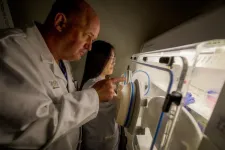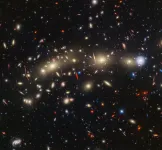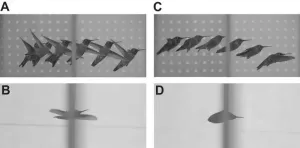(Press-News.org) Is the US reporting system for vaccine safety broken?
Investigation raises concerns that the system is not operating as intended and signals are being missed
A US reporting system designed to detect potential safety issues with vaccines is supposed to be user-friendly, responsive, and transparent. But an investigation published by The BMJ today finds it’s not meeting its own standards.
The Vaccine Adverse Event Reporting System (VAERS), co-managed by the US Centers for Disease Control and Prevention (CDC) and the Food and Drug Administration (FDA), collects reports of symptoms, diagnoses, hospitalisations, and deaths following vaccination that might indicate a possible safety concern about a vaccine, explains journalist Jennifer Block.
It relies on a mixture of voluntary adverse event reports from doctors and patients and mandatory reporting from vaccine manufacturers, which are required by law to report all adverse events of which they are aware.
According to VAERS’ standard operating procedure for covid-19, reports must be processed quickly, within days of receipt.
But The BMJ has learned that in the face of an unprecedented 1.7 million reports since the rollout of the covid-19 vaccines, VAERS staffing was likely not commensurate with the demands of reviewing serious reports submitted, including reports of death.
Freedom of Information Act (FOIA) documents seen by The BMJ suggest that Pfizer has more than 1,000 more full time employees than the CDC, despite the latter’s responsibility for handling adverse event reports for all manufacturers.
What’s more, other countries have acknowledged deaths “likely” or “probably” related to mRNA vaccination, whereas the CDC, which says it has reviewed nearly 20,000 reports (far more than other countries) hasn’t acknowledged a single death linked to mRNA vaccine.
The BMJ has spoken to more than a dozen people, including a number of physicians and a state medical examiner, who have filed VAERS reports of a serious nature on behalf of themselves or patients and were never contacted by clinical reviewers, or were contacted months later.
Some were told conflicting information about updating their report or discouraged from making a report altogether.
A group of physicians and advocates have met multiple times with representatives of the FDA between 2021 and 2022 to express their concerns that the system is not operating as intended and signals are being missed.
In response to several questions about these meetings and the issues raised therein, the FDA responded by email that the agency “is actively engaged in safety surveillance of these vaccines to identify and address potential safety concerns” and that “physicians and epidemiologists from the FDA and CDC continuously screen and analyse data from VAERS for covid-19 vaccines to identify potential signals that would indicate the need for further study.”
The BMJ has also found that the FDA and CDC essentially maintain two separate VAERS databases - a public-facing database containing only initial reports, and a private, backend system containing all updates and corrections - for example, a formal diagnosis, recovery, or a death.
CDC told The BMJ that this was to protect patient confidentiality. Yet, interestingly, Block notes that the FDA’s adverse event reporting system (FAERS), which collects reports on drugs, does maintain a publicly accessible database that gets updated, as does the Medical Device Reporting system, raising the question of why VAERS can’t do the same.
Neither the CDC nor the FDA provided an explanation. An FDA spokesperson told The BMJ that “patients can submit formal requests under FOIA to obtain the full record of their report.”
For serious cases, reporters to VAERS are supposed to receive emails prompting them for updates. It includes a code and upload link, but reporters The BMJ spoke with didn’t get confirmation emails, and if they search for their report in the database it will remain unchanged. Similarly, if a reporter successfully treated their diagnoses and improved, or confirmed that the cause for their illness was unrelated to a vaccine, that would not be reflected in the public database.
Narayan Nair, the FDA division director who oversees VAERS, acknowledged in a meeting with advocates that people get frustrated when they look for an updated report, find the original untouched, and feel like they’re “being ignored.” “They never see it on the front end, because we don't alter that initial report.”
[Ends]
END
Is the US reporting system for vaccine safety broken?
Investigation raises concerns that the system is not operating as intended and signals are being missed
2023-11-10
ELSE PRESS RELEASES FROM THIS DATE:
Gut bacteria protects against diarrhoeal disease
2023-11-10
Gut bacteria protects against diarrhoeal disease
Peer reviewed - Systematic review – people and animals
The severity of a diarrhoeal disease could be down to the bacteria in your gut – according to new research from the University of East Anglia.
Cryptosporidiosis is responsible for over 100,000 deaths annually – predominantly in children under five.
It also affects animals, and a new study published today shows that large animals – including primates - with less different ...
Found at last: Bizarre, egg-laying mammal finally rediscovered after 60 years
2023-11-10
A long-beaked echidna named after Sir David Attenborough and last seen by scientists in 1961 has been photographed for the first time in an Indonesian tropical forest.
An international team of researchers worked with local communities to deploy over 80 camera traps to film the elusive animal.
Besides rediscovering the echidna, the team uncovered a wealth of species completely new to science, including beetles, spiders, and a remarkable tree-dwelling shrimp.
A wide range of images and video footage from the expedition are available (see link below).
More than sixty years after it was last recorded, an expedition ...
WHO updates its guidance on treatments for COVID-19
2023-11-10
A panel of international experts representing the World Health Organization’s Guideline Development Group has updated its guidance on treatments for patients with covid-19.
The new recommendations published by The BMJ are part of a living guideline, developed by the World Health Organization with the methodological support of MAGIC Evidence Ecosystem Foundation, to provide up to date, trustworthy guidance on the management of covid-19 and help doctors make better decisions with their patients.
The guidance ...
UTHealth Houston researchers awarded $2.6 million NIH grant to study molecular pathways and potential strategies for treatment of myocardial ischemia and reperfusion injury
2023-11-10
A four-year, $2.6 million grant to study circadian rhythm and novel therapies to protect the heart during a heart attack or cardiac surgery has been awarded to UTHealth Houston by the National Heart, Lung, and Blood Institute, part of the National Institutes of Health.
Principal investigator Holger Eltzschig, MD, PhD, professor, and co-investigator Wei Ruan, MD, PhD, assistant professor, from the Department of Anesthesiology, Critical Care and Pain Medicine at McGovern Medical School at UTHealth Houston, are studying translational, pharmacologic, and interventional strategies targeting ...
What human diseases can teach us about the immune system
2023-11-10
The immune system is a crucial part of our survival, regularly fending off wide-ranging attacks on the body, both internal and external. Unsurprisingly, the elegant defense system that protects us from viruses, bacterial infections, cancer, and other threats is immensely complicated. Each time it mounts a response, it must quickly and carefully orchestrate communication across vast numbers of cells and molecules.
Jennifer Oyler-Yaniv is working to figure out how, exactly, the immune system does this — and when and why it fails.
“There's always the next question, the next ...
Texas A&M researchers contribute to international project studying coronavirus transmission in humans, cattle
2023-11-10
Researchers from the Texas A&M School of Veterinary Medicine and Biomedical Sciences’ (VMBS) Veterinary Education, Research, and Outreach (VERO) program have joined an international team studying how coronaviruses are spread and whether an individual’s microbiome (the collection of microbes living in or on the body) might impact that transmission.
Coronaviruses are a family of viruses that can cause a variety of diseases in many species, from the common cold and severe acute respiratory syndrome (SARS) in people, to diarrhea in calves and respiratory disease in ...
NASA’s Webb, Hubble telescopes combine to create most colorful view of universe
2023-11-10
Astronomers once again have combined the observational powers of NASA’s James Webb Space Telescope and Hubble Space Telescope to create one of the most detailed and colorful portraits of the cosmos, just in time for the holiday season.
The new image, dubbed the Christmas Tree Galaxy Cluster by the research team that includes Texas A&M University astronomer Dr. Lifan Wang, combines visible light from Hubble with infrared light detected by Webb to showcase MACS0416, a galaxy cluster about 4.3 billion light-years from Earth. Because the cluster is able to magnify the light from more distant background galaxies through a phenomenon known as gravitational ...
Ten 2023 postdoctoral fellowships in aging research awarded by the Glenn Foundation for Medical Research and AFAR
2023-11-10
NEW YORK, NY and SANTA BARBARA, CA — The American Federation for Aging Research (AFAR) and the Glenn Foundation for Medical Research are pleased to announce the recipients of the 2023 Glenn Foundation for Medical Research Postdoctoral Fellowships in Aging Research. This program supports postdoctoral fellowswho study basic research mechanisms of aging and/or translational findings that have potential to directly benefit human health.
Selected through a rigorous review process, ten, one-year, $75,000 Postdoctoral ...
Mystery solved: how hummingbirds fly through gaps that are too small
2023-11-10
Soaring, wings outstretched, many birds sail through the air unhindered. However, species that dine on fruit, seeds and nectar must negotiate tiny gaps in cluttered foliage to secure a feast. To pass through apertures, many birds pull in their wings, folding them closer to their bodies. However, some of the most manoeuvrable aviators, hummingbirds, have lost the ability to fold their wings at the wrists and elbows. ‘Unless hummingbirds implement distinctive strategies to transit narrow apertures, they may be unable to enter gaps less than one wingspan wide’, ...
Hummingbirds' unique sideways flutter gets them through small apertures
2023-11-10
Most birds that flit through dense, leafy forests have a strategy for maneuvering through tight windows in the vegetation — they bend their wings at the wrist or elbow and barrel through.
But hummingbirds can't bend their wing bones during flight, so how do they transit the gaps between leaves and tangled branches?
A study published today in the Journal of Experimental Biology shows that hummingbirds have evolved their own unique strategies — two of them, in fact. These strategies have not been reported before, likely because hummers maneuver too ...
LAST 30 PRESS RELEASES:
Numbers in our sights affect how we perceive space
SIMJ announces global collaborative book project in commemoration of its 75th anniversary
Air pollution exposure and birth weight
Obstructive sleep apnea risk and mental health conditions among older adults
How talking slows eye movements behind the wheel
The Ceramic Society of Japan’s Oxoate Ceramics Research Association launches new international book project
Heart-brain connection: international study reveals the role of the vagus nerve in keeping the heart young
Researchers identify Rb1 as a predictive biomarker for a new therapeutic strategy in some breast cancers
Survey reveals ethical gaps slowing AI adoption in pediatric surgery
Stimulant ADHD medications work differently than thought
AI overestimates how smart people are, according to HSE economists
HSE researchers create genome-wide map of quadruplexes
Scientists boost cell "powerhouses" to burn more calories
Automatic label checking: The missing step in making reliable medical AI
Low daily alcohol intake linked to 50% heightened mouth cancer risk in India
American Meteorological Society announces Rick Spinrad as 2026 President-Elect
Biomass-based carbon capture spotlighted in newly released global climate webinar recording
Illuminating invisible nano pollutants: advanced bioimaging tracks the full journey of emerging nanoscale contaminants in living systems
How does age affect recovery from spinal cord injury?
Novel AI tool offers prognosis for patients with head and neck cancer
Fathers’ microplastic exposure tied to their children’s metabolic problems
Research validates laboratory model for studying high-grade serous ovarian cancer
SIR 2026 delivers transformative breakthroughs in minimally invasive medicine to improve patient care
Stem Cell Reports most downloaded papers of 2025 highlight the breadth and impact of stem cell research
Oxford-led study estimates NHS spends around 3% of its primary and secondary care budget on the health impacts of heat and cold in England
A researcher’s long quest leads to a smart composite breakthrough
Urban wild bees act as “microbial sensors” of city health.
New study finds where you live affects recovery after a hip fracture
Forecasting the impact of fully automated vehicle adoption on US road traffic injuries
Alcohol-related hospitalizations from 2016 to 2022
[Press-News.org] Is the US reporting system for vaccine safety broken?Investigation raises concerns that the system is not operating as intended and signals are being missed





